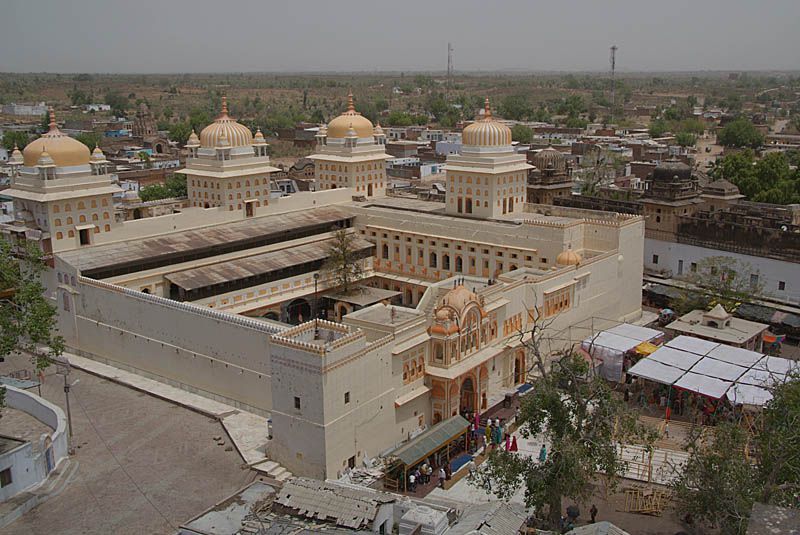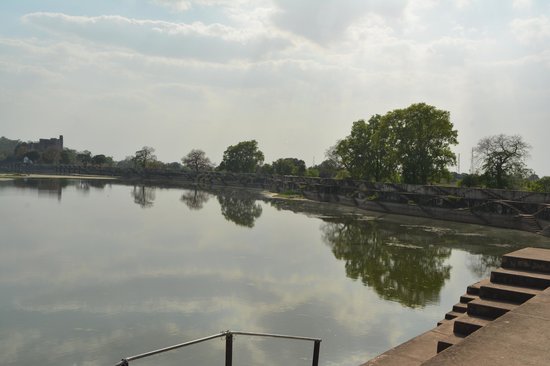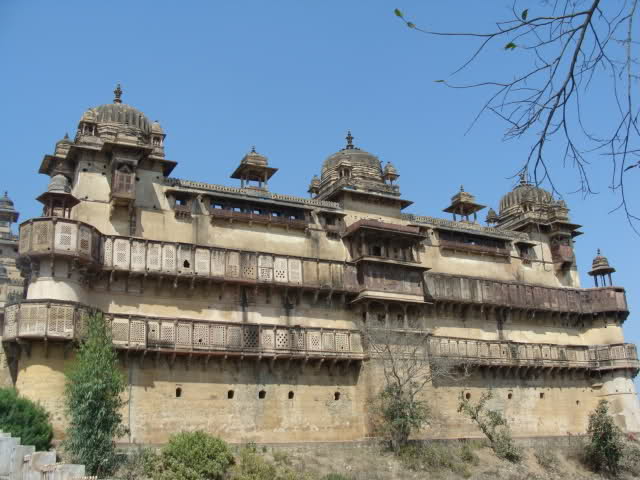Best of India Tours
- Golden Triangle Tour- Best of India & Nepal
- Classical Rajasthan
India Cultural Tours
- Images of North India- Karnataka Heritage
- Rajasthan & Goa Tour
Discover India Tours
- Grand India Tour- North to South India
- Central to South India
Rajasthan Tours
- Classical Rajasthan Tour- Golden Triangle Tour
- Grand Mughal Tour
India Luxury Trains
- Palace on Wheels- The Golden Chariot
- India Deccan Odyssey
- The Indian Maharaja
- Royal Rajasthan on Wheels
Nepal Tours
- Glimpses of Nepal- Buddhist Pilgrimage
- Nepal River Rafting
- Destinations of Nepal
- Nepal General Info
India Wildlife Tours
- North India Wild Life- South India Wildlife
Tibet Tours
- Tibet Monastery Tours- Explore Tibet
- Destinations of Tibet
Spa & Yoga Tours
- Ananda in Himalayas- Yoga & Meditation
Adventure Tours
- Manali Safari Tour- Himalayan Trekking
- Horse Safari
Orchha
Bandhavgarh
![]() Bhopal
Bhopal
![]() Gwalior
Gwalior
![]() Indore
Indore
![]() Jabalpur
Jabalpur
![]() Kanha
Kanha
![]() Khajuraho
Khajuraho
![]() Mandu
Mandu
![]() Orchha
Orchha

Orchha, now a small hamlet in the state of Madhya Pradesh, was once the capital of the formidable Bundela kings who ruled over a large tract between the Ganga and Narmada in medieval times. According to legends, King Rudra Pratap chose this place situated on the loop of the river Betwa to make his capital in AD 1501. Located at a distance of 16 km from Jhansi, Orchha rises out of the hills and the greens surrounding it. The historical monuments of Orchha still retain their pristine charm and narrate stories of war and peace, of love and destruction. It is also a place famous for Bundela paintings, of which it was once a centre of activity.
Nevertheless, Orchha is not all about history and legends; it is also about the natural splendour of a wonderful valley where the crystal-clear waters of the Betwa flow quietly along the banks for which solitude is a way of life.
Sightseeing
Most of the attractions in Orchha are situated in the fort complex consisting of palaces, temples, cenotaphs, and memorials. The complex can be reached by a multi-arched bridge where you would find three palaces in a quadrangle. Raj Mahal or King’s Palace was built by King Madhukar Shah, a contemporary of Emperor Akbar. Jahangir Mahal was built by Raja Bir Singh Ju Deo in 1606 to commemorate the visit of Mughal Emperor Jahangir. Legends say that Rai Parveen Mahal was built by King Indramani for his favourite concubine Rai Parveen. Like Raj Mahal, Raja Ram Temple is also a contribution of King Madhukar Shah with a very unusual story behind it. Chaturbhuj and Laxmi Narayan temples are some of the other important religious attractions in Orchha.
Excursions
Being a part of the Bundelkhand region of Central India, there are several historical and religious places in the vicinity of Orchha that can be visited on a daylong trip. Jhansi is a place closely associated with Rani Laxmibai who fought against the British during the Revolt of 1857. Her fort in Jhansi is the reminder of her courage and fighting spirit. Talbehat has a spectacular fort built by the King of Bar and Chanderi. Barua Sagar is a dam created on the Betwa River. Paricha is another dam on the Betwa River famous for its rich beauty. Deogarh (literally, the Fort of the Gods) is situated on the right bank of the Betwa River at the western end of the Lalitpur range of hills. Mahoba is associated with the invincible Chandela Kings, who are also credited with the construction of the Khajuraho temples. Chitrakoot is a pilgrimage associated with many legends of Lord Ram.
Excursions for Orchha
Raj Mahal
One of the oldest historical monuments in the fort complex, the Raj Mahal or King’s Palace is famous for its chhatris (cenotaphs) and exquisite murals on the interiors. The palace has a number of rooms that dealt with exclusive functions. There is the private room for the king, a room for the guests who used to receive special favours from the King, and many rooms for his harem.

Jahangir Mahal

Considered as the best piece of architecture in Orchha, the Jahangir Mahal is the reminder of friendship that prevailed between the Mughals and Bundelas for a long time. The palace is situated a few steps away from the Rai Praveen Mahal, another important palace of Orchha. The main gate of the palace has two bowed elephants on each side accentuating the Islamic architectural style that is the hallmark of this palace. The palace also gives breathtaking views of surrounding areas from its numerous multi-storeyed balconies.
Rai Praveen Mahal
It is a small, two-storeyed palace mostly in ruins now. Legends say that king Indramani built this palace after his favourite concubine and used to come here after a hectic day\’s work. There was a time when the palace buzzed with beauty and grace of its inhabitants as well as the charm of its gardens. Rai Parveen was a gifted poetess and dancer and it should not have been tough for the king to fall for her charms. The height of the palace has been designed to match the height of the trees in the surrounding gardens.

Ram Raja Temple

The Ram Raja Temple is perhaps the most important—though unusual—of all the temples in Orchha. This is the only temple in the country where Rama is worshipped as a king—that too in a palace. According to legends, once Lord Rama appeared in a dream to king Madhukar Shah and directed him to build a temple for him. The king followed the instructions given by Rama and brought his idol from Ayodhya, the birthplace of the lord. However, the construction of the temple was not complete when the idol arrived from Ayodhya. So it was kept in the palace for the time being. Later, the king remembered that in the dream Lord Rama had specifically mentioned that his idol could not be removed from the place where it has been originally kept. This led the king to abandon the construction of the temple and instead the palace where the idol was kept was converted into a temple.
Chaturbhuj Temple
Built on a massive stone platform, the Chaturbhuj temple was originally built to house the idol of Lord Rama. A number of steps lead to the temple. Up on the platform, one can have splendid views of the beautiful surroundings

Lakshmi Narayan Temple (Orchha)

The Lakshmi Narayan temple is at a higher altitude suited more for a fort. The architecture of the temple gives a feeling of ethnic India\’s royal taste. The temple also has some very beautiful and rare paintings. The post-mutiny paintings of this temple are very famous.
Barua Sagar
Situated 26 km northeast of Orchha, in the neighbouring state of Uttar Pradesh, Barua Sagar is a dam created on the Betwa River. It provides excellent views of the surrounding area. One can enjoy a swim in the lake or go for a walk in its beautiful environs. While here, one can also pay a visit to the Pratihara temple and the Jarai-ka-Math dedicated to Lord Shiva and Goddess Parvati. This place has a great historical importance as a battle between the Peshwas and the Bundela kings was fought here.

Chitrakoot

A part of the Bundelkhand region, Chitrakoot is situated in the region bordering Uttar Pradesh and Madhya Pradesh. According to the Ramayana, Lord Rama and his wife spent 11 out of 14 years of their exile in the jungles around Chitrakoot. Most of the attractions of Chitrakoot are situated along the Mandakini like Janki Kund, Ram Ghat, Sphatic Shila, Dev Ganga, Sati Anasuya, and Hanuman Dhara.
Deogarh (Orcha)
Situated on the right bank of the Betwa in the western range of Lalitpur hills, Deogarh enjoyed political importance right from the Gupta Age. Its location on the main route from Delhi to Deccan has also ensured that it always remained a bone of contention. The main attraction here is the Deogarh Temple, dedicated to Lord Vishnu. This is the earliest-known Panchyatan temple in north India. The architectural plan of the temple displays terraced basement above the high plinth decorated with sculpted panels. Other highlights are the figures of Ganga and Yamuna that adorn the carved doorway leading to the sanctum sanctorum. Many parts of the temple are now ruined except the Anantshayi Vishnu depicting scenes from Vaishnava mythology. Two other attractions are the Karnali Fort perched on the hills that overlook river Betwa and the Deogarh Archaeological Museum with its fine collection of early Hindu sculptures.

Jhansi Fort

The fort was built by Raja Bir Singh in the 17th century purely for defence, as is evident by its location on the top of a hill. The fort was taken under siege by the mutineers in 1857 and they slaughtered all the occupants (mostly British). After the mutiny, the British ceded the fort to the Scindias of Gwalior and exchanged it for Gwalior in 1866. The fort houses the well-known Karak Bijli Tank as well as a museum with a good collection of sculptures and other remains
Mahoba
Capital of the legendary Chandelas, who ruled over this region between 9th and 11th centuries, Mahoba is a place full of stories of warrior kings. There is a fort atop a hill showing the might of Chandelas as well as lakes built by them. The temples in Mahoba are built in the same style as that of Khajuraho. Today, the town of Mahoba is also known for its production of betel leaves and granite rocks.
Paricha

Paricha in Uttar Pradesh is a dam built on the river Betwa. It is famous for its scenic beauty.
Talbehat Fort
Talbehat, situated in Jhansi district, has a majestic fort surrounded by a swamp. Talbehat derives its name from Tal (lake) and Behat (village)—a name given by the Gond tribe who were the original inhabitants of this place. The fort was built by Bharat Shah, the Raja of Bar and Chanderi in 1618. The fort also houses the famous Narsingh Temple.

Fact File
 Best Time to Visit:October to March
Best Time to Visit:October to March
 Languages:Hindi, English
Languages:Hindi, English
 STD Code:07680
STD Code:07680




